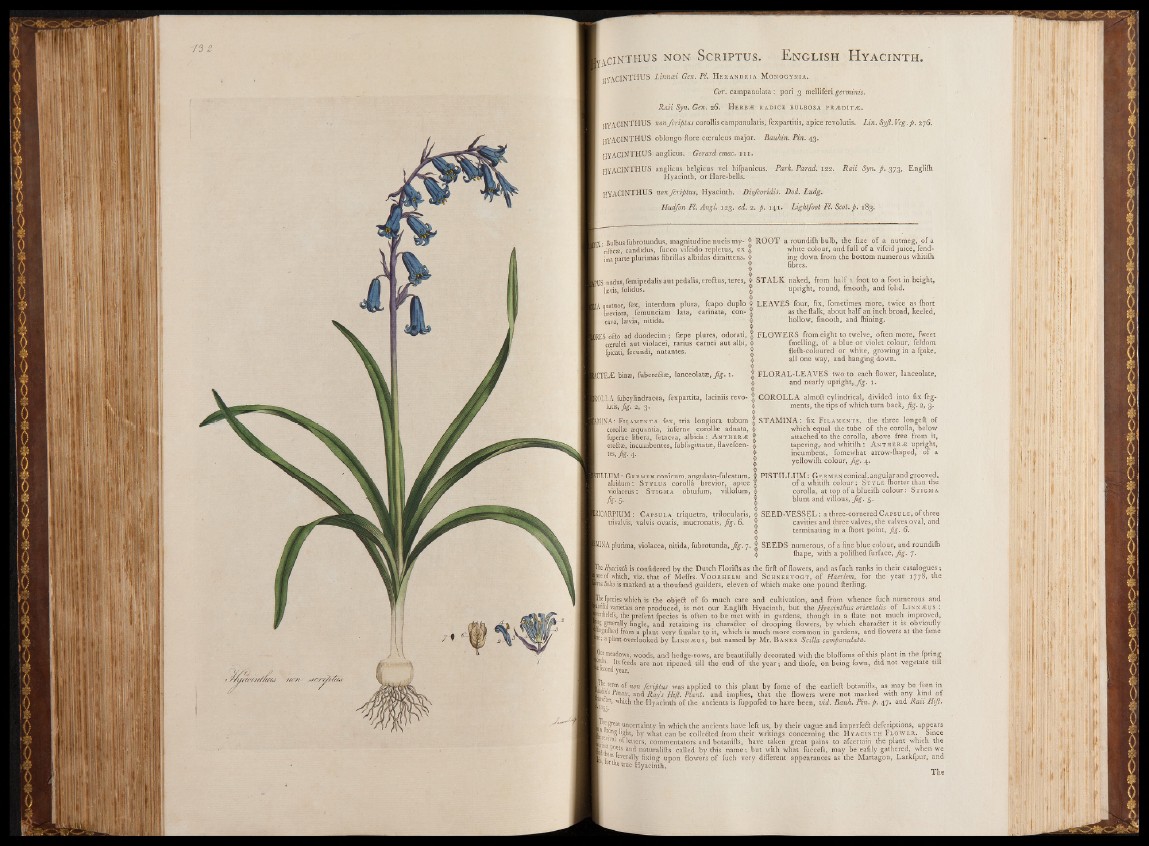
HYACINTHUS Linncei Gen. PI. H e x a n d r ia M o n o g y n ia .
Cor. campanulata: pori 3 melliferi germinis.
Raii Syn. Gen. 26. H erbie r a d ic e bu l b o sa pr jEd it aj,
HYACINTHUS non fcriptus corollis campanulatis, fexpartitis, apice revolutis. Lin. Syjl. Veg.p. 276.
HYACINTHUS oblongo flore cceruleus major. Bauhin. Pin. 43.
HYACINTHUS anglicus. Gerard, emac. 111.
HYACINTHUS anglicus belgicus vel hifpanicus. Park. Parad. 122. Raii Syn. p. 373, Engliftl
Hyacinth, or Hare-bells.
HYACINTHUS nonfcriptus, Hyacinth. Diofcoridis. Dod. Ludg.
Hudfon FI. Angl. 123. ed. 2. p. 141. Lightfoot FI. Scot. p. 183.
k; Bulbus fubrotundus, magnitudine nucis my-1
I rifticae, candidus, fucco vifcido repletus, e x |
ima parte plurimks fibrillas albidas dimittens. 3
\
>US nudus,femipedalisautpedalis,ere&us, teres, <
laevis, folidus.
k quatuor, fex, interdum plura, {capo duplo *
1 breviora, femunciam lata, carinata, con- \
I cava, lævia, nitida.
RES ofto ad duodecim ; fæpe plures, odorati,
I coerulei aut violacei, rarius carnei aut albi,
J fpicati, fecundi, nutantes.
iCTEÆ binæ, fubere&æ, lanceolatae, fig. 1.
ÎOLLA fubcylindracea, fexpartita, laciniis revolutis,
fig. 2, ;'3* ' ]
MINA : Fil am en ta fex, tria Iongiora tubum \
corollæ æquantia, inferne corollæ adnata, *
fuperne libera, fetacea, albida: A n th e ræ '
ereâæ, incumbentes, fubfagittatæ, flavefcen- ■
tes, fig. 4..
ROOT a roundifh bulb, the fize of a nutmeg, of a
white colour, and full of a vifcid juice, fend-
. . ing down from the bottom numerous whitilh
fibres.
> STA LK naked, from half a foot to a foot in height,
upright, round, fmooth, and folid.
:» , . .
> LEAVES four, fix, fometimes more, twice as fhort
as the ftalk, about half an inch broad, keeled,
hollow, fmooth, and Ihining.
I FLOWERS from eight to twelve, often more, fweet
i fmelling, of a blue or violet colour, feldom
flefh-coloured or white, growing in a fpike,
l, all one way, and hanging down.
| FLORAL-LEAVES two to each flower, lanceolate,
$ and nearly upright, jig. 1.
| COROLLA almoft cylindrical, divided into fix feg-
$ ments, the tips of which turn back, jig. 2, 3.
STAMINA: fix Filaments, the three longeft of
which equal the tube of the corolla, below
attached to the corolla, above free from it,
tapering,, and whitifh : A n th er s upright,
incumbent, fomewhat arrow-fhaped, of a
yellowifh colour, jig. 4.
TILLUM : G ermen conicum, angulato-fulcatum,
albidum: S t y l u s corolla brevior, apice
violaceus : S t ig m a obtufum, villofum,
fiS ’ 5 ; :
i PISTILLUM: G ermen conical, angular and grooved,
of a whitilh colour: Sty le fhorterthan the
corolla, at top of a blueifh colour: S tigma
blunt and villous, jig. 5.
^ICARPIUM : C a p su l a triquetra, trilocularis, SEED-VESSEL: a three-cornered C a p su l e , of three
trivalvis, valvis ovatis, mucronatis, fig. 6. ^ cavities and three valves, the valves oval, and
$ terminating in a fhort point, fig. 6.
pNA plurima, violacea, nitida, fubrotunda, jig. 7. | SEEDS numerous, of a fine blue colour, and roundifh
$ fhape, with a polifhed furface, jig. 7.
jne Hyacinth is confidered by the Dutch Florifts as the firft of flowers, and as fuch ranks in their catalogues ;
ieof which, viz. that of Meffrs. V o o rhe lm and S c h n e e v o g t , of Haerlem, for the year 1778, the
'a Solis is marked at a thoufand guilders, eleven of which make one pound fterling.
_ e fpecies which is the objeft of fo much care and cultivation, and from whence fuch numerous and
Itiful varieties are produced, is not our Englifii Hyacinth, but tht Hyacinthus orientalis of L innaeus :
Jrthelefs, the prefent fpecies is often to be met with in gardens, though in a ftate not much improved,
p generally fingle, and retaining its character of drooping flowers, by which charafler it is obvioufly
j'nguilhed from a plant very fimilar to it, which is much more common in gardens, and flowers at the fame
; a plant overlooked by L innaeus', but named by Mr. B anks Scilla campanulata.
pt meadows, woods, and hedge-rows, are beautifully decorated with the blofloms of this plant in the fpring
• Its feeds are not ripened till the end of the year; and thofe, on being fown, did not vegetate till
|}ccond year.
■ ,? ,ter™ of non fcriptus was applied to this plant by fome of the earliefl: botanifts, as may be feen in
rj?'t Pinax, and Rays Hift. Plant, and implies, that the flowers were not marked with any kind ;of
jr erJ which the Hyacinth of the ancients is fuppofed to have been, vid. Bauh. Pin. p. 47. and Raii Hift.
I r.0nS light, by what can be colleóted from their writings concerning the H y a c in t h F l o w e r .
ipvival of letters, commentators and botanifts, have taken great pains to afcertain the plant which the
1 th P°ftS and naturalifts called by this name; but with what fuccefs, may be eafily gathered, when we
I f0 rn,leverally fixing upon flowers of fuch very different appearances as the Martagon, Larkfpur, and
true Hyacinth,